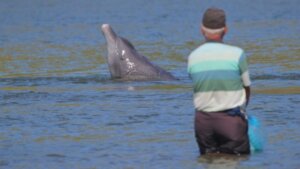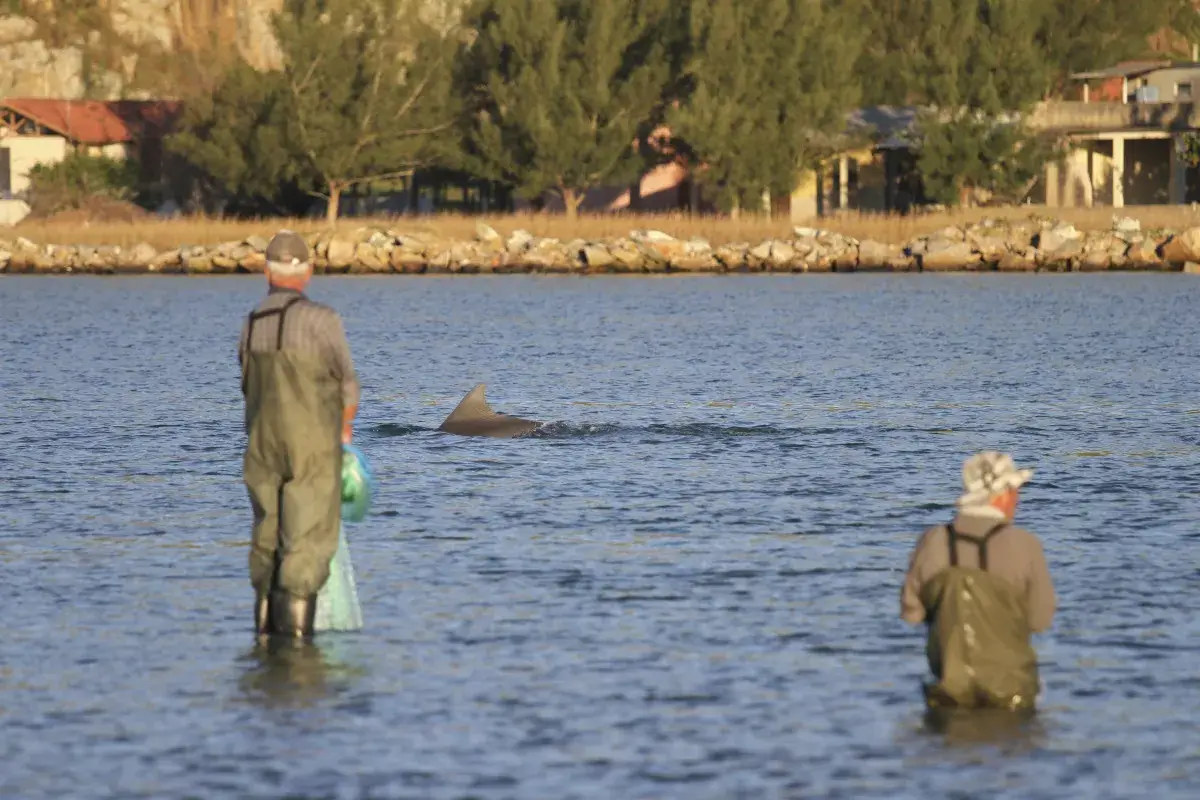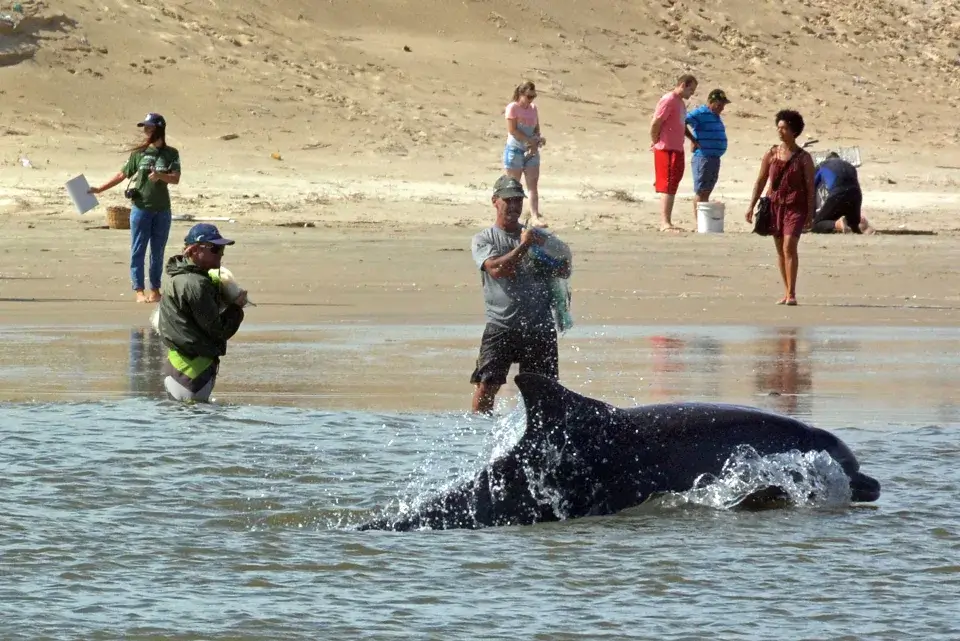Find Out All About Fishing with Dolphins

Although humans have domesticated a certain number of animals throughout history, interspecific relationships have proven to be more than just limited to trained species. Such is the case with the inhabitants of a small region in southern Brazil and a group of wild dolphins, who join forces and take part in fishing with dolphins.
Read on to find out more about this interesting natural phenomenon.
Bottlenose dolphins, the best allies
In the coastal city of Laguna, in southern Brazil, humans and bottlenose dolphins come together with the same goal – to catch the coveted mullet fish. Although this practice has been documented for several years, the scientific community didn’t know how the cooperativity between these two species of mammals worked.
In fact, a recent study published in the journal Proceedings of the National Academy of Sciences has shed more light on this natural phenomenon. According to this research, in which drones and underwater recordings were used to monitor the cetaceans’ movements, the collaborative work operates in several stages.
First, the dolphins locate the schools of fish using their echolocation sound system, then group them together and take them to the coastal areas, where it’s easier to catch them. This is of great help to fishermen, as the turbidity of the water makes it almost impossible to see the schools of fish.
Then, when people see the dolphins doing this work, they prepare their nets, waiting for a signal to make the next move. Finally, when the cetaceans hit their heads and tails against the waves or jump over the water, the fishermen cast their nets, as this is the signal for a successful catch.

A very productive relationship
According to the study, this ancestral relationship generates excellent benefits for both species. On the one hand, the inhabitants who work with dolphins have 17 times more success in fishing than those who fish alone.
On the other hand, the dolphins take advantage of when the fish are left in the nets to eat them from there. In addition, researchers affirm that cetaceans that cooperate with humans are 13% more likely to survive.
A mutual relationship with many dynamics
Contrary to what one might think, not all Laguna dolphins participate in cooperative fishing with humans. In fact, only 45% of this marine population does so, while the rest hunt on their own.
Although the reason for this behavior isn’t known, there are some interesting facts about how the relationship with humans influences the dolphins’ social life.
According to research published in the journal Biology Letters, dolphins that participate in fishing with humans have a greater affinity with those that do the same. That is, there’s a greater connection between dolphins engaged in the same activities.
Accordingly, the researchers suggest that cooperation with humans is somehow involved in the social organization of bottlenose dolphins with their environment. Likewise, the study The structure of a bottlenose dolphin society is coupled to a unique foraging cooperation with artisanal fishermen points out that dolphins transmit and teach this type of behavior to new generations, thus ensuring the survival of this practice over the years.

Fishing with dolphins, in danger of disappearing
Mutual relationships between humans and animals began more than 10,000 years ago with the domestication of the first wild wolves during the Mesolithic period. Thanks to this type of biological interaction, for the first time, two different species were able to obtain benefits in exchange for working as a team.
But, as with other natural phenomena, the pollution and destruction of ecosystems has threatened cooperative fishing between humans and dolphins. In addition, industrial fishing has led to a reduction in the number of people engaged in this activity.
It’s important to know that the valuable cooperation between different species has become a cultural tradition. Therefore, it deserves to be preserved above economic benefit.
It’s in our hands, and in those of future generations, to ensure not only the existence of bottlenose dolphins, but also the preservation of such a fantastic interaction that, unfortunately, is becoming scarcer every day.
All cited sources were thoroughly reviewed by our team to ensure their quality, reliability, currency, and validity. The bibliography of this article was considered reliable and of academic or scientific accuracy.
- Cantor, M., & Farine, D. (2023). Foraging synchrony drives resilience in human-dolphin mutualism. 120(6), e2207739120. https://www.pnas.org/doi/full/10.1073/pnas.2207739120
- Daura-Jorge, F., Cantor, M., Ingram, S., Lusseau, D., & Simões-Lopes, P. (2012). The structure of a bottlenose dolphin society is coupled to a unique foraging cooperation with artisanal fishermen. Biology Letters, 8(5), 702-705. https://royalsocietypublishing.org/doi/abs/10.1098/rsbl.2012.0174
- Machado, A., Cantor, M., Costa, A., Righetti, B., Bezamat, C., Valle-Pereira, J., & Daura-Jorge, F.(2019). Homophily around specialized foraging underlies dolphin social preferences. Biology Letters, 15(4), 20180909. https://royalsocietypublishing.org/doi/10.1098/rsbl.2018.0909
- Simões-Lopes, P., Fabián, M., & Menegheti, J. (1998). Dolphin interactions with the mullet artisanal fishing on Southern Brazil: a qualitative and quantitative approach. Revista Brasileira de Zoologia, 15. https://www.scielo.br/j/rbzool/a/njwcWPqRLKKftKJkPWfcj9n/?lang=en#
- Zhang, Z., Khederzadeh, S., & Li, Y. (2020). Deciphering the puzzles of dog domestication. Zool Res, 41(2), 97-104. https://www.ncbi.nlm.nih.gov/pmc/articles/PMC7109016/
This text is provided for informational purposes only and does not replace consultation with a professional. If in doubt, consult your specialist.